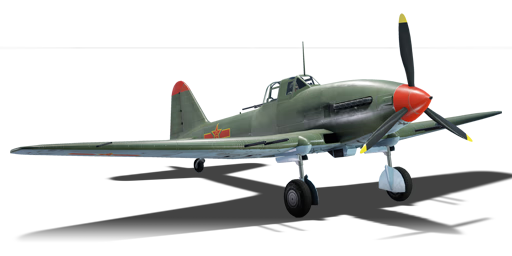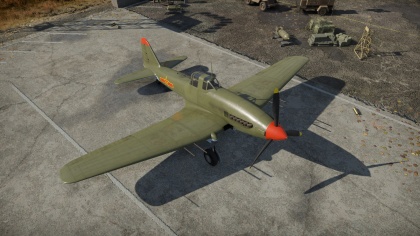IL-10 (1946) (China)
Contents
| This page is about the Chinese attacker IL-10 (1946) (China). For other versions, see IL-10 (Family). |
Description
The ␗IL-10 (1946) is a rank Chinese attacker
with a battle rating of (AB), (RB), and (SB). It was introduced in Update 1.91 "Night Vision".
General info
Flight performance
Describe how the aircraft behaves in the air. Speed, manoeuvrability, acceleration and allowable loads - these are the most important characteristics of the vehicle.
| Characteristics | |||||||
|---|---|---|---|---|---|---|---|
| Stock | |||||||
| Max Speed (km/h at 2,650 m) |
Max altitude (meters) |
Turn time (seconds) |
Rate of climb (meters/second) |
Take-off run (meters) | |||
| AB | RB | AB | RB | AB | RB | ||
| ??? | ??? | ??.? | ??.? | ??.? | ??.? | 550 | |
| Upgraded | |||||||
| Max Speed (km/h at 2,650 m) |
Max altitude (meters) |
Turn time (seconds) |
Rate of climb (meters/second) |
Take-off run (meters) | |||
| AB | RB | AB | RB | AB | RB | ||
| 552 | 528 | 22.8 | 24.0 | 13.9 | 10.4 | 550 | |
Details
| Features | ||||
|---|---|---|---|---|
| Combat flaps | Take-off flaps | Landing flaps | Air brakes | Arrestor gear |
| X | ✓ | ✓ | X | X |
| Limits | ||||
|---|---|---|---|---|
| Wing-break speed (km/h) |
Gear limit (km/h) |
Combat flaps (km/h) |
Max Static G | |
| + | - | |||
| 320 | ~13 | ~13 | ||
| Optimal velocities | |||
|---|---|---|---|
| Ailerons (km/h) |
Rudder (km/h) |
Elevators (km/h) |
Radiator (km/h) |
| < 370 | < 410 | < 400 | > 323 |
| Compressor (RB/SB) | ||
|---|---|---|
| Setting 1 | ||
| Optimal altitude | 100% Engine power | WEP Engine power |
| 1,500 m | 1,770 hp | 2,009 hp |
Survivability and armour
- 6 mm Steel - Propeller hub plate
- 8 mm Steel - Engine surround plating
- 6 mm Steel - Under cockpit plate, under gunner plate, under the rear gun plate, the canopy frame plate
- 8.5 mm Steel - Rear gunner plate
- 8 mm Steel - Headrest plate between pilot/gunner
- 64 mm Bulletproof glass - Front canopy
The Il-10 is a very well-defended plane. It has armour protection all throughout the front half of the fuselage, and a sturdy construction makes this plane able to withstand even high-calibre cannon rounds.
Armaments
Offensive armament
The Il-10 (1946) is armed with:
- 4 × 23 mm NS-23 cannons, wing-mounted (150 rpg = 600 total)
Suspended armament
The Il-10 (1946) can be outfitted with:
- 2 x 50 kg FAB-50 bombs
- 2 x 100 kg FAB-100 bombs
- 2 x 250 kg FAB-250M43 bombs
- 4 x RS-82 rockets + 2 x 50 kg FAB-50 bombs
- 4 x RBS-82 rockets + 2 x 50 kg FAB-50 bombs
- 4 x RS-132 rockets + 2 x 50 kg FAB-50 bombs
- 4 x RBS-132 rockets + 2 x 50 kg FAB-50 bombs
- 4 x RS-82 rockets + 2 x 100 kg FAB-100 bombs
- 4 x RBS-82 rockets + 2 x 100 kg FAB-100 bombs
- 4 x RS-132 rockets + 2 x 100 kg FAB-100 bombs
- 4 x RBS-132 rockets + 2 x 100 kg FAB-100 bombs
Defensive armament
The Il-10 (1946) is defended by:
- 1 × 20 mm B-20E cannon, dorsal turret (300 rpg)
Usage in battles
NS-23 cannons are not capable of destroying medium or light tanks even with AP ammunition. This severely hinders the aircraft's ground attack capabilities, so it is best utilized as a multi-purpose aircraft similar to the B7A2 Ryusei. However, it is worth noting that this aircraft wields the ability to carry a varied payload of both bombs and rockets. With proper aim, it is possible to destroy heavy tanks albeit very difficult as there is no bombing reticule. The "air targets" belt for the 23 mm cannons have the ability to demolish soft ground targets such as armoured cars and AAA units, but also retains the ability to destroy fighters and bombers alike with only a handful of rounds. Therefore, it can be beneficial to first attack the enemy's light defences and then if a teammate has been forced to a lower altitude by a pursuer, attempting to alleviate the stress of that pilot can be beneficial. Like the La-9, the IL-10 (1946) has the ability to fire two of it's 23 mm cannons instead of four as the ammunition pools are separate. A good strategy is to use one set of 23 mm belts for attacking ground targets, and the other for destroying enemy aircraft.
If found in a sticky situation, the IL-10 (1946) pilot may choose to call for help or to "roll the dice" and use the 20 mm tail cannon. While it is effective, hitting the enemy at longer distances can be very difficult, especially without the "new 20 mm cannon (turret)" module upgrade. It is best to lure an enemy by turning and evading their fire and then lining them up directly with your tail cannon. It is possible to destroy the enemy aircraft with less than 10 shells if they are very close and the tail gunner is accurate. Another unorthodox method of using the 20 mm tail cannon involves a situation in which an initial pass on a ground target failed. Depending on how close the IL-10 (1946) is to the ground target, it is possible to destroy it from behind with the 20 mm tail gun. This is very difficult especially as the distance from the target increases.
Manual Engine Control
| MEC elements | ||||||
|---|---|---|---|---|---|---|
| Mixer | Pitch | Radiator | Supercharger | Turbocharger | ||
| Oil | Water | Type | ||||
| Controllable | Controllable Not auto controlled |
Not controllable Not auto controlled |
Controllable Auto control available |
Separate | Not controllable 1 gear |
Not controllable |
Modules
| Tier | Flight performance | Survivability | Weaponry | ||
|---|---|---|---|---|---|
| I | Fuselage repair | Radiator | Offensive 23 mm | ||
| II | Compressor | Airframe | New 23 mm cannons | ||
| III | Wings repair | Engine | Turret 20 mm | RO-82 | |
| IV | Engine injection | Cover | New 20 mm cannons (turret) | RO-132 | |
Pros and cons
Pros:
- Forward-firing 4 x 23 mm cannons can do massive damage
- Defensive 20 mm gunner with 300 rounds of ammunition for protection (won't always save you, but can bring down stupid enemy fighters reliably)
- Accelerates rather quickly (useful for gaining distance from a failed ground strike)
- Versatile payload of bombs and rockets
- Highly armoured cockpit
- Durable aircraft, can absorb damage
- Good manoeuvrability for an attacker
Cons
- Large aircraft, easy target
- 23 mm are difficult to aim due to low muzzle velocity
- Lots of armour plating in the cockpit, hinders visibility (if playing SB)
- Cannot perform high-speed manoeuvres
- Bleeds energy extremely quickly
- Very slow roll rate
- Low top speed, manoeuvrability and climb rate
- NS-23 still does not have the penetration to damage medium tanks, even with API-T at optimal angles.
- Almost no protection for the rear gunner
History
Describe the history of the creation and combat usage of the aircraft in more detail than in the introduction. If the historical reference turns out to be too long, take it to a separate article, taking a link to the article about the vehicle and adding a block "/History" (example: https://wiki.warthunder.com/(Vehicle-name)/History) and add a link to it here using the main template. Be sure to reference text and sources by using <ref></ref>, as well as adding them at the end of the article with <references />. This section may also include the vehicle's dev blog entry (if applicable) and the in-game encyclopedia description (under === In-game description ===, also if applicable).
Media
Excellent additions to the article would be video guides, screenshots from the game, and photos.
See also
Links to the articles on the War Thunder Wiki that you think will be useful for the reader, for example:
- reference to the series of the aircraft;
- links to approximate analogues of other nations and research trees.
External links
Paste links to sources and external resources, such as:
- topic on the official game forum;
- encyclopedia page on the aircraft;
- other literature.
| Ilyushin Design Bureau (Илью́шинa Опытное конструкторское бюро) | |
|---|---|
| Bombers | DB-3B · IL-4 |
| Jet Bombers | IL-28* · IL-28Sh |
| Strike Aircraft | IL-8 (1944) |
| Il-2 | IL-2 (1941) · IL-2 (1942) · IL-2M type 3 · IL-2M "Avenger" · IL-2M (1943) · IL-2-37 · IL-2 M-82 |
| Il-10 | IL-10 · IL-10 (1946) |
| Export/Captured | |
| Bombers | ␗DB-3A · ◊IL-28 · ◔IL-28 |
| Strike Aircraft | ▀IL-2 (1942) · ␗IL-10 (1946) · ◔IL-10 |
| * The Chinese Harbin Aircraft Manufacturing Corporation built unlicensed copies of the Il-28 known as the H-5. | |
| China twin-engine fighters and strike aircraft | |
|---|---|
| Twin-engine fighters | ␗Ki-45 hei/tei · ␗P-38L-1 |
| Strike aircraft | V-11 · V-12D · ␗IL-10 (1946) · Mosquito FB.Mk.26 |





